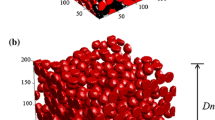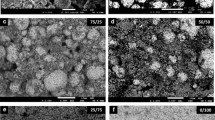Abstract
In this paper, the particle packing-based discrete element method is applied to study the correlations between the microstructural parameters and electrochemical performances of LSM-LSCF composite electrodes. Firstly, through the verification of domain size independence and the comparison with the percolation theory, the computational domain size and effectiveness of the particle packing are determined. Then, the changes of the electrochemical reaction sites in the composite electrode with the LSM volume fraction under two different ratios of particle radius are investigated, including the LSM-LSCF-pore three-phase boundaries (TPBs) per electrode volume, TPBs per electrolyte surface, and percolated LSCF-pore double phase boundaries (DPBs). The distribution characteristics of the LSM-LSCF-pore TPBs within and outside the threshold volume fraction zone at different particle size ratio cases are obtained. When the particles are of equal radius, the formation of both percolated e−, O2−, and O2 transport paths is in the LSM volume fraction range of 0 to 0.7, due to the electronic conducting path is fully connected. The distribution characteristics of the LSCF-pore DPBs within the electrode in the percolation area and outside the percolation area are obtained respectively. This work is of great significance for the follow-up study of the physical and electrochemical processes within porous composite electrodes based on large-scale complex morphology.








Similar content being viewed by others
References
Yang J, Muroyama H, Matsui T, Eguchi K (2010) A comparative study on polarization behavior of (La,Sr)MnO3 and (La,Sr)CoO3 cathodes for solid oxide fuel cells. Int J Hydrog Energy 35(19):10505–10512
Jiang SP (2012) Nanoscale and nano-structured electrodes of solid oxide fuel cells by infiltration: advances and challenges. Int J Hydrog Energy 37(1):449–470
Matsui T, Komoto M, Muroyama H, Kishida K, Inui H, Eguchi K (2016) Degradation factors in (La,Sr)(Co,Fe)O3-δ cathode/Sm2O3–CeO2 interlayer/ Y2O3–ZrO2 electrolyte system during operation of solid oxide fuel cells. J Power Sources 312:80–85
Zhang C, Grass ME, McDaniel AH, DeCaluwe SC, El Gabaly F, Liu Z, McCarty KF, Farrow RL, Linne MA, Hussain Z, Jackson GS, Bluhm H, Eichhorn BW (2010) Measuring fundamental properties in operating solid oxide electrochemical cells by using in situ X-ray photoelectron spectroscopy. Nat Mater 9(11):944–949
Yang L, Wang S, Blinn K, Liu M, Liu Z, Cheng Z, Liu M (2009) ChemInform Abstract: Enhanced sulfur and coking tolerance of a mixed ion conductor for SOFCs: BaZr0.1Ce0.7Y0.2-xYbx O3-δ. ChemInform 40, (50).
Liu Z, Liu M, Yang L, Liu M (2013) LSM-infiltrated LSCF cathodes for solid oxide fuel cells. J Energy Chem 22(4):555–559
Wilson JR, Kobsiriphat W, Mendoza R, Chen HY, Hiller JM, Miller DJ, Thornton K, Voorhees PW, Adler SB, Barnett SA (2006) Three-dimensional reconstruction of a solid-oxide fuel-cell anode. Nat Mater 5(7):541–544
Visscher WM, Bolsterli M (1972) Random packing of equal and unequal spheres in two and three dimensions. Nature 239(5374):504–507
Suzuki M, Oshima T (1983) Estimation of the co-ordination number in a multi-component mixture of spheres. Powder Technol 35(2):159–166
Bouvard D and, Lange FF (1991) Relation between percolation and particle coordination in binary powder mixtures. Acta Metallurgica Et Materialia.
Chen D, He H, Zhang D, Wang H, Ni M (2013) Percolation theory in solid oxide fuel cell composite electrodes with a mixed electronic and ionic conductor. Energies 6(3):1632–1656
Gostovic D, Smith JR, Kundinger DP, Jones KS, Wachsman ED (2007) Three-dimensional reconstruction of porous LSCF cathodes. Electrochem Solid-State Lett 10(12):B214
Wilson JR, Duong AT, Gameiro M, Chen HY, Thornton K, Mumm DR, Barnett SA (2009) Quantitative three-dimensional microstructure of a solid oxide fuel cell cathode. Electrochem Commun 11(5):1052–1056
Wilson JR, Cronin JS, Duong AT, Rukes S, Chen H-Y, Thornton K, Mumm DR, Barnett S (2010) Effect of composition of (La0.8Sr0.2MnO3–Y2O3-stabilized ZrO2) cathodes: correlating three-dimensional microstructure and polarization resistance. J Power Sources 195(7):1829–1840
Smith JR, Chen A, Gostovic D, Hickey D, Kundinger D, Duncan KL, Dehoff RT, Jones KS, Wachsman ED (2009) Evaluation of the relationship between cathode microstructure and electrochemical behavior for SOFCs. Solid State Ionics 180(1):90–98
Izzo JR, Joshi AS, Grew KN, Chiu WKS, Tkachuk A, Wang SH, Yun W (2008) Nondestructive reconstruction and analysis of SOFC anodes using X-ray computed tomography at Sub50 nm resolution. J Electrochem Soc 155(5):B504–B508
Zhang Y, Yan F, Hu B, Xia C, Yan M (2020) Chemical relaxation in porous ionic–electronic conducting materials represented by the distribution of characteristic times. J Mater Chem A 8.
Gonzalez RC, Woods RE, Eddins SL (2009) Digital Image Processing Using MATLAB, 2nd ed. Publishing House of Electronics Industry
Kishimoto M, Iwai H, Saito M, Yoshida H (2011) Quantitative evaluation of solid oxide fuel cell porous anode microstructure based on focused ion beam and scanning electron microscope technique and prediction of anode overpotentials. J Power Sources 196(10):4555–4563
Kennouche D, Chen-Wiegart YCK, Riscoe C, Wang J, Barnett SA (2016) Combined electrochemical and X-ray tomography study of the high temperature evolution of Nickel – Yttria Stabilized Zirconia solid oxide fuel cell anodes. J Power Sources 307(Mar.1):604–612
Li T, Heenan TMM, Rabuni MF, Wang B, Farandos NM, Kelsall GH, Matras D, Tan C, Lu X, Jacques SDM (2019) Design of next-generation ceramic fuel cells and real-time characterization with synchrotron X-ray diffraction computed tomography. Nat Commun 10(1)
Kenney B, Valdmanis M, Baker C, Pharoah JG, Karan K (2009) Computation of TPB length, surface area and pore size from numerical reconstruction of composite solid oxide fuel cell electrodes. J Power Sources 189(2):1051–1059
Choi HW, Berson A, Pharoah JG, Beale SB (2011) Effective transport properties of the porous electrodes in solid oxide fuel cells. Proceedings of the Institution of Mechanical Engineers Part A Journal of Power and Energy 225(2):183–197
Zheng K, Zhang Y, Li L, Ni M (2015) On the tortuosity factor of solid phase in solid oxide fuel cell electrodes. Int J Hydrog Energy 40(1):665–669
Moussaoui H, Laurencin J, Gavet Y, Delette G, Hubert M, Cloetens P, Le Bihan T, Debayle J (2018) Stochastic geometrical modeling of solid oxide cells electrodes validated on 3D reconstructions. Comput Mater Sci 143:262–276
Holzer L, Münch B, Iwanschitz B, Cantoni M, Hocker T, Graule T (2011) Quantitative relationships between composition, particle size, triple phase boundary length and surface area in nickel-cermet anodes for Solid Oxide Fuel Cells. J Power Sources 196(17):7076–7089
Zhang Y, Yan F, Yan M, Wan Y, Jiao Z, Xia C, Chen F, Ni M (2019) High-throughput, super-resolution 3D reconstruction of nano-structured solid oxide fuel cell electrodes and quantification of microstructure-property relationships. J Power Sources 427:112–119
Yan Z, He A, Hara S, Shikazono N (2019) Modeling of solid oxide fuel cell (SOFC) electrodes from fabrication to operation: correlations between microstructures and electrochemical performances. Energy Convers Manag 190:1–13
Funding
We gratefully acknowledge the financial support of the National Natural Science Foundation of China (51776092), Ministry of Science and Technology of China (CU03-10), and Jiangsu Province ‘333’ High Level Talents Project and Project of Jiangsu University High-Tech Ship Collaborative Innovation Center (2019, 1174871801-11).
Author information
Authors and Affiliations
Corresponding author
Additional information
Publisher’s note
Springer Nature remains neutral with regard to jurisdictional claims in published maps and institutional affiliations.
Rights and permissions
About this article
Cite this article
Li, J., Huang, Q., Lei, Q. et al. The effects of microstructural parameters on the electrochemical properties of LSM-LSCF composite cathode by the particle-based discrete element method. Ionics 27, 2901–2907 (2021). https://doi.org/10.1007/s11581-021-04082-1
Received:
Revised:
Accepted:
Published:
Issue Date:
DOI: https://doi.org/10.1007/s11581-021-04082-1




